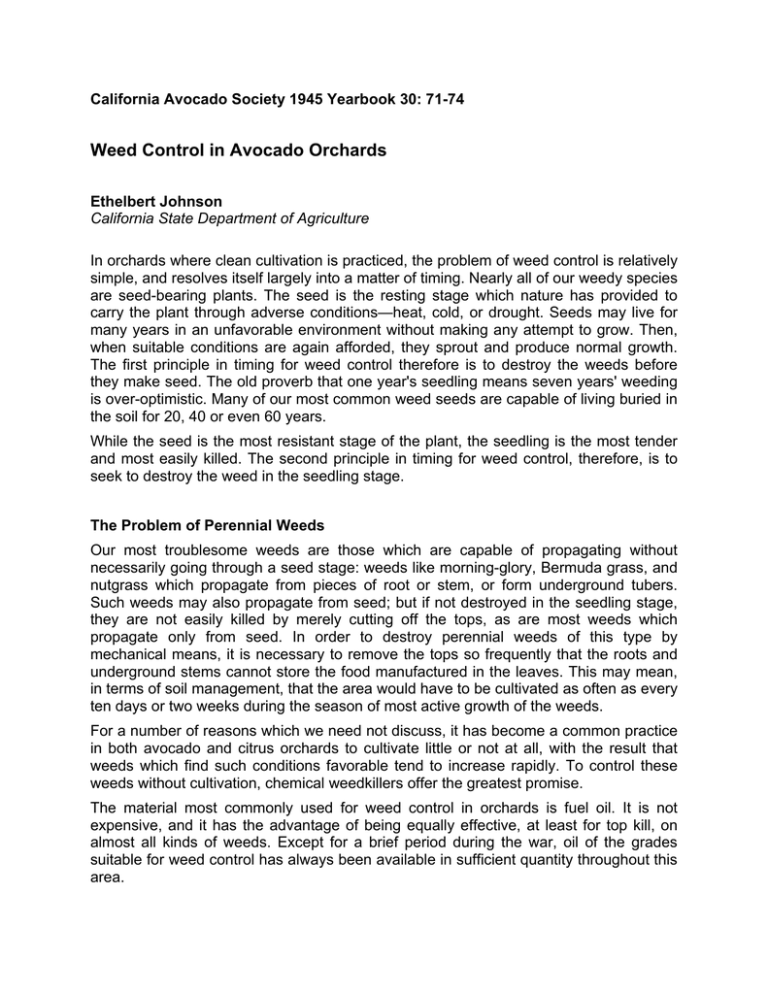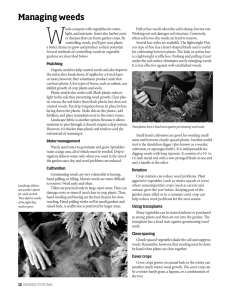Weed Control in Avocado Orchards
advertisement

California Avocado Society 1945 Yearbook 30: 71-74 Weed Control in Avocado Orchards Ethelbert Johnson California State Department of Agriculture In orchards where clean cultivation is practiced, the problem of weed control is relatively simple, and resolves itself largely into a matter of timing. Nearly all of our weedy species are seed-bearing plants. The seed is the resting stage which nature has provided to carry the plant through adverse conditions—heat, cold, or drought. Seeds may live for many years in an unfavorable environment without making any attempt to grow. Then, when suitable conditions are again afforded, they sprout and produce normal growth. The first principle in timing for weed control therefore is to destroy the weeds before they make seed. The old proverb that one year's seedling means seven years' weeding is over-optimistic. Many of our most common weed seeds are capable of living buried in the soil for 20, 40 or even 60 years. While the seed is the most resistant stage of the plant, the seedling is the most tender and most easily killed. The second principle in timing for weed control, therefore, is to seek to destroy the weed in the seedling stage. The Problem of Perennial Weeds Our most troublesome weeds are those which are capable of propagating without necessarily going through a seed stage: weeds like morning-glory, Bermuda grass, and nutgrass which propagate from pieces of root or stem, or form underground tubers. Such weeds may also propagate from seed; but if not destroyed in the seedling stage, they are not easily killed by merely cutting off the tops, as are most weeds which propagate only from seed. In order to destroy perennial weeds of this type by mechanical means, it is necessary to remove the tops so frequently that the roots and underground stems cannot store the food manufactured in the leaves. This may mean, in terms of soil management, that the area would have to be cultivated as often as every ten days or two weeks during the season of most active growth of the weeds. For a number of reasons which we need not discuss, it has become a common practice in both avocado and citrus orchards to cultivate little or not at all, with the result that weeds which find such conditions favorable tend to increase rapidly. To control these weeds without cultivation, chemical weedkillers offer the greatest promise. The material most commonly used for weed control in orchards is fuel oil. It is not expensive, and it has the advantage of being equally effective, at least for top kill, on almost all kinds of weeds. Except for a brief period during the war, oil of the grades suitable for weed control has always been available in sufficient quantity throughout this area. The threat of an oil shortage during the war stimulated research to find a substitute. Several materials have been found which are even more satisfactory than oil for the control of many weeds, but none that equal the effectiveness of oil as a universal weedkiller without risk of damage to trees or soil. The grades of oil available are low in toxicity, in the sense that relatively large quantities are required to kill weeds. For example, if it took 100 gallons of spray to treat an acre of seedling weeds, this would mean about 700 pounds of oil. To make 100 gallons of some of the more toxic weedkillers, only one or two pounds would be required, the rest being water. The property of oil which makes it superior to water solutions as a weedkiller is its ability to penetrate plant tissues. This is of the greatest importance in those plants in which the growing points are concealed or protected. This is the case with most grasses. If a leaf of avocado or pigweed is cut, it makes no further growth in length, but may grow in width, the growing tissues being along the margins of the leaf. When a lawn is mowed, the grass blades continue to elongate, not from the tip, but from the point where blade and sheath join. New leaves and stems grow from below and push their way up through the sheaths of older leaves. Oil in sufficient quantity penetrates these protecting sheaths, as well as the hairy or waxy surfaces which interfere with wetting by water solutions. Science undoubtedly can develop a water-soluble pene-trant, but so far we have nothing to offer equal to oil in this respect. Some New Chemicals Offer Promise While oil is the best all-around weedkiller now available, it is not as satisfactory as some other chemicals for those weeds like morning-glory which reproduce from underground stems, and sprout up again as soon as the top is killed. Where the weed occurs in a open field, away from tree roots, carbon bisulphide may be used, literally fumigating the soil and destroying the deep roots of the weed. Being volatile, it soon leaves the soil without permanent injury. Along the roadside or elsewhere in locations not to be used for planting, and in which no tree roots are growing, sodium chlorate is satisfactory, if applied on the surface of the soil during the rainy season. In most soils, the chlorate moves freely and is carried by rainfall to the feeding roots of the weeds. Arsenic is poisonous to plants in very small quantities, and has been the active ingredient in most commercial weedkillers. It may be used as a contact spray to kill top growth, as a soil sterilizer to prevent the growth of seedlings, and within narrow limitations as a translocated poison to kill morning-glory and a few other deep-rooted perennials by application to the stems and leaves. These limitations, briefly, require a vigorous top growth, followed by a moisture deficit, at which time a downward pressure occurs in the plant permitting it to take the chemical rapidly through the woody conducting tissues of the stems into the underground stems and roots. Although practical methods have been developed for its use in the field, the conditions under which it can be successfully applied, particularly in orchards, are so limited that failures have been the rule rather than the exception. The Hormone Weed Killers Interest in other weedkillers has recently been supplanted by the discovery of the properties of "2,4-D" (2,4-dichlorophenoxyacetic acid). We have observed it under California conditions only since October, 1944, following the first publication of its weedkilling properties in August of that year. With the lifting of war censorship, we learn that British scientists have been working with similar materials for an even longer period, and have reached, independently, many of the same conclusions. Prom our observations, extending now about one year, we do not hesitate to recommend 2,4-D for the control of morning-glory and a number of other weeds, along roadsides and in non-agricultural land. We do not have sufficient information on the damage it may do to trees and soil to recommend its use in orchards or on land which is to be planted to crops. In order better to understand what we may expect from 2,4-D, it may be of interest to consider what it is and how it was discovered. In the study of the phenomena of growth, plant physiologists found that growth and dormancy were attended by chemical changes in the tissues capable of growth: buds, new leaves, cambium, and root-tips. The chemicals associated with these changes were called hormones, from a Greek word meaning "to set in motion." The same hormone in different concentrations often induces various responses. Thus, a minute quantity might stimulate growth, and cause plant cuttings to root more readily or fruit to form without pollination. A somewhat larger quantity of the same hormone might retard growth and prolong dormancy of delay the ripening of fruit. A still higher concentration would induce abnormal growth, resulting often in the death of the plant. The composition of hormones can be reproduced by synthetic chemistry, and other compounds of similar structure and even more powerful effects can be formed. The product which we know as 2,4-D was selected from a number of such compounds as most suitable for commercial production as a weedkiller. The concentration necessary to kill plants is high as compared with the concentrations required to stimulate or retard growth, but it is extremely low when compared to other herbicides. As little as one-half pound of 2-4-D is enough for 100 gallons of weedkiller. Not all plants are equally affected by 2,4-D. Grasses in general are resistant, for the reason, already discussed, that the growing tissues on which the chemical acts are concealed and protected. Some grasses also, even in the seedling stage, are tolerant to higher concentrations than many other plants. Woody shrubs, such as poison oak and blackberries, are easily killed only if sprayed at a time when new growth is taking place. Herbaceous plants which make rapid growth are the most easily killed, particularly those which are easily wet. Again, results are best when application is made at a time of active growth, poorest when mature or approaching dormancy. The list of weeds which can be killed is long. It includes most broad-leaved annuals; rosette-type perennials such as dandelion, plantain, and dock; and creeping perennials such as morning-glory, ragweed, Russian knapweed and many others. The responses of different species to applications of 2,4-D are quite varied. That of morning-glory is typical. An abnormal twisting of the tips of the vines is first noticeable, giving the appearance of wilting, although both stems and leaves are found to be abnormally stiff and turgid. Blossoming ceases, and the foliage takes on a dull hue, gradually yellowing and eventually dying. At the same time, the underground stems become swollen, discolored and spongy, ultimately disintegrating. The entire process may take from one to several weeks. Hormone Sprays Dangerous to Crop Plants The effect on trees and crops is similar. In general, those crops which make i the most rapid growth are the most readily affected. Avocados and citrus during a growth cycle are extremely sensitive, as are also beans, cotton, grapevines, and rosebushes. A drift of spray too slight to be noticed may show up in damage to trees or crops a hundred feet away. Even the small amount of 2,4-D adhering to the walls of a spray tank after several washings was sufficient to cause damage to lemon trees later sprayed with oil from the same tank. Trees affected by 2,4-D usually show twisted or swollen twigs of new growth, the bark often splitting and the entire twig dying from the tip back. The leaves sometimes twist or curl, sometimes grow into abnormal shapes. Even new growth starting from buds formed after application of the chemical is often abnormal. On tissues in which growth has ceased, such as bark and mature leaves, little if any effect is apparent. None of the citrus or avocado trees we have seen affected by 2,4-D has yet died, although several have continued to show decline as much as six months after injury. It is not yet apparent whether injury to a few twigs of a tree is accompanied by corresponding injury to cambium and roots, as it is in herbaceous plants. Seedlings and young plants are affected by minute quantities of 2-,4-D in the soil. Roots are stunted and tend to form many buds which fail to develop. The effect on the soil is the subject of studies being carried on at the University of California at Davis. As little as one-third pound of 2,4-D to the acre-foot has been found to sterilize the soil so that peas will not grow. It required 23 pounds to prevent the growth of oats in the same soil type. Beans and beets failed to grow in fields treated with 2-,4-D for morning-glory control, as much as ten weeks after treatment. No weeds sprouted on a treated area for four months during the rainy season. British investigators are understood to have found sterilization for as long as six months. In orchards, temporary sterilization of the surface soil would not necessarily be injurious to the trees; but if the chemical reaches the feeding roots in sufficient concentration, damage may be expected. Rainfall is the agency most likely to cause concentration of soluble substances in the soil at a given depth. Experience with other weedkillers, such as sodium chlorate and ammonium sulfamate, has shown that they can often be used around orchard trees without apparent injury; but after the next rainy season serious damage may develop. Certain irrigation practices might have similar results. More commonly, damage does not immediately follow irrigation. Our knowledge to date indicates that in California, late spring and early summer, after the rainy season, would be the safest time to use 2,4-D in orchards in order to allow the maximum time for decomposition before the next rainy season. Research now in progress should afford the answers to many of these questions, and in time we may be able to predict the conditions under which 2,4-D may be used safely in orchards and cropland. Until then the damage experienced in many instances in which it has been tried should serve as a warning to proceed with the utmost caution.






